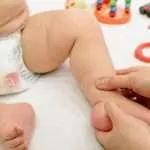While urinary tract infections (UTIs) most commonly afflict baby girls, infant boys remain at substantial risk as well from bacteria creeping up the urinary tract to the bladder. However, certain key anatomical and hormonal differences in baby boys mandate tailored preventative strategies centered on circumcision status, foreskin hygiene, and congenital urinary tract anomaly surveillance – as voiding pattern habits and toilet training concerns diverge from infant girls. This article will help parents understand how to prevent UTI in baby boy, cover unique considerations for minimizing UTIs in baby boys to safeguard both short and long-term kidney health.
Key Takeaways
- Teach retraction and cleaning under foreskin after diapering/urination
- Correct any congenital kidney defects like posterior urethral valves
- Ensure balanitis inflammation and phimosis foreskin tightness receives prompt treatment
- Encourage adequate hydration and vitamin C intake making urine bacteria-resistant
- Avoid constipation and impacted bowel movements irritating bladder
Unique UTI Risk Factors in Baby Boys
Compared to the shorter female urethra length allowing easier bacterial access into the bladder, baby boys possess key anatomical differences including longer urethras and bacterial barriers from antimicrobial prostate secretions. However, obstruction at any level of the urinary tract – from the renal pelvis to the urethral meatus – can retard urine flow and increase UTI susceptibility from stagnant pooling. Major UTI risk factors in baby boys involve:
Phimosis
Phimosis refers to a tight, non-retractable foreskin that cannot slide back fully, which affects around 8% of boys by age 17. Trapped moisture under the foreskin attracts bacteria while phimosis obstructs outward drainage. Strong urine spraying력n also further irritate the tip and urethral opening.
Balanitis
Balanitis describes inflammation of the glans penis and foreskin, predominantly arising from poor hygiene and skin irritation. Recurrent balanitis lowers local immune factors allowing catheter migration through damaged skin. Diabetes also predisposes to yeast superinfection.
Posterior Urethral Valves
Posterior urethral valves (PUV) represent inward tissue folds within the urethra causing partial or complete obstruction. Backed up urine flows towards the kidneys raising infection risk. PUV occurs in 1 in 5000 to 8000 males.
Uncircumcised Status
Multiple studies correlate circumcision status with substantially reduced UTI rates given easier cleaning and absence of moist bacterial cultures brewing under foreskin folds. However, specific hygiene teaching can confer comparable protections.
Targeting these prevalent risk factors through proactive interventions forms the cornerstone of preventing recurrent UTI misery in baby boys.
Unique UTI Risk Factors in Baby Boys
Key UTI risk factors in baby boys include phimosis foreskin tightness, balanitis inflammation from poor cleaning, congenital posterior urethral valves obstructing urine outflow, and uncircumcised status unless diligent under-foreskin hygiene is taught.
Diet and Lifestyle Approaches For UTI Prevention
Just as in baby girls, certain dietary adjustments help inhibit bacterial expansion in the urinary tract while healthy voiding patterns minimize urine stagnation permitting uncontrolled microbial festering. Key diet and lifestyle UTI prevention strategies for baby boys mirror those in girls:
Adequate Hydration
Sufficient water and electrolyte intake allows regular diluted urination without urine retention permitting bacterial overgrowth in the bladder. However juices and sweet drinks often exacerbate UTIs despite hydration provision.
Vitamin C Foods
Incorporating fruits and vegetables high in vitamin C like oranges, broccoli and tomatoes creates acidic urine less hospitable to bacterial colonization and outgrowth. However, megadoses via supplementation do not enhance UTI prevention further.
Probiotics and Yogurt Research demonstrates that providing infants and toddlers daily probiotic supplements enriches protective microbiota along the urinary tract outcompeting pathogenic strains. Maternal yogurt ingestion also populates babies with UTI-resistant vaginal flora during childbirth.
Fiber For Regulated Bowel Movements
Adequate fiber intake softens stools preventing painful defecation and voiding requiring intense abdominal straining. This avoids pressure increases transmitted to the bladder provoking vesicoureteral reflux and UTIs. Soluble fibers also latch onto and remove cholesterol-containing UTI-causing bacteria species.
While emerging research explores complementary agents like D-mannose and cranberry derivatives showing early promise in recurrent UTI prevention, mainstay strategies for baby boys still emphasize adequate hydration, vitamin C, probiotics, regulated bowel habits, and教n uncircumcised infants教 proper hygiene below with gentle retraction.
Lifestyle Approaches
- Increased water intake for diluted urine
- Vitamin C foods acidifying urine
- Maternal and infant probiotic supplementation
- High fiber diets preventing constipation
- Teaching foreskin retraction and cleaning in uncircumcised boys
Foreskin Care and Retraction Teaching
Uncircumcised male infants remain especially vulnerable to recurrent UTIs before age 5 given challenges keeping underneath folds of tissue clean. Pediatricians play key roles demonstrating to parents proper foreskin cleaning steps during routine visits:
Gently Retract Foreskin
Show parents how to gently ease the foreskin back during diaper changes before wiping and cleaning. Avoid any forced retraction which could cause small tears promoting bacterial invasion. Retain expert guidance managing phimosis narrowing the foreskin opening using topical steroids when conservative measures fail.
Wipe and Wash After Urination Thoroughly wipe and cleanse the tip and inside fold of the foreskin after urination to prevent pooled urine festering infectious bacteria colonization. Consider fragrance/alcohol free wipes avoiding irritation.
Dry Thoroughly
After washing under warm water, gently pat dry using soft cotton towels/gauze. Yeast and fungi thrive in persistently moist, dark environments under the foreskin. Never insert cotton swabs forcefully avoiding microabrasions increasing infection risks.
Inspect Skin Integrity
Check underneath the foreskin during routine bathing and diaper changes for any redness, swelling, odor or discharge suggestive of balanitis inflammation which requires anti-fungal treatments if involving yeast, or antibiotics for suspected bacterial overgrowth. Catching balanitis early prevents ascending urinary infections.
Consider Circumcision
For recurrent UTIs despite diligent foreskin hygiene measures, surgical circumcision permanently exposes the tip lacking protective microbiota barriers preventing bacterial colonization in the vulnerable neonatal period. Discuss risks vs benefits of the procedure if UTIs continue despite conservative efforts.
With stepwise education starting from when parents first begin retracting and cleaning at home during regular bathing and diapering, nurses and doctors can significantly curb UTIs in uncircumcised boys no longer shielded by the foreskin without proper daily exposure.
Foreskin Care Education
- Gentle retraction not forcing tight phimosis
- Wiping and washing after urination
- Drying thoroughly preventing fungal overgrowth
- Inspecting for concerning balanitis signs
- Referring refractory cases for circumcision consideration
Congenital Defect Screening
For baby boys with recurrent UTIs not responding well to dietary modifications, voiding pattern regulations, probiotic supplementation and foreskin hygiene optimizations, obtaining a renal bladder ultrasound followed by voiding cystourethrogram imaging helps screen for congenital kidney issues heightening infection susceptibility from urine backflow and stalled drainage.
Most common congenital findings include:
Posterior Urethral Valves
Posterior urethral valves (PUV) represent tissue flaps inside the penile urethra causing partial or complete urine flow obstruction. This backed up urine increases pressure upwards towards the kidneys, bladder and ureters, heightening infection risks, while also impairing natural drainage following urination events. First line therapy involves endoscopic valve ablation, though valves can recur needing repeat resection. Clean intermittent urinary catheterization temporarily relieves obstruction as well.
Vesicoureteral Reflux In vesicoureteral reflux (VUR), abnormal urine backflow from the bladder retrogrades up towards the kidneys against normal drainage direction. This not only impairs urination efficiency requiring higher bladder pressures, but also propels bacteria laden fluids kidney-wards provoking recurrent pyelonephritis. Definitive therapy requires surgical ureteral reimplantation redirecting one-way urine flow.
Ureteropelvic Junction Obstruction
Here, narrowing around the junction between the renal pelvis funneling collecting ducts downwards from the renal parenchyma impedes urine propulsion from the kidney into the ureter towards the bladder. Just as with posterior valves, accumulating back pressure dilates urinary tract structures increasing stagnant urine pooling allowing uncontrolled bacterial expansion generating repeat UTIs. Both endoscopic and open flank surgery can reconstruct the stenotic UPJ.
Once anatomical defects land on the diagnostic radar through ultrasound screening then direct visualization via voiding cystourethrogram, urology referral helps select optimal surgical approach whether resection, reimplantation or reconstruction to remove UTI provoking outflow impediments in baby boys – just as similar corrective surgeries successfully reduce UTI rates in young girls likewise facing obstructed urinary drainage.
Congenital Defect Screening
- Posterior urethral valve resection
- Vesicoureteral reflux repair
- Ureteropelvic junction narrowing correction
Outcomes from Preventative Measures
Employing such dietary adjustments towards acidified, flowing urine, conservatively managing phimosis with steroid creams before resorting to surgery, properly retracting and cleaning under the foreskin, screening for posterior valves or reflux causing repeated urine obstruction or backflow, and surgically correcting anatomical anomalies drops recurrent UTI rates down to just 0-5% in most studies, compared to 35% peak averages in high risk groups.
This not only rapidly resolves painful burning urinary symptoms from active infections, but also confers lasting protections:
Immediate Outcomes
- Reversal of fever, poor feeding, vomiting during infections
- Reduced pyelonephritis kidney infections requiring hospitalization
- Stable growth curves without setbacks during illness periods
Lasting Effects
- Preserved kidney filtration not ending in early dialysis dependence
- Avoidance of urosepsis from recurring infection seeding to the bloodstream
- Intact fertility given lower genitourinary tract scarring risks
- No limb swelling or hypertension over time with protected nephron mass
Therefore, prompt preventative efforts yield both instant and lifelong safeguards for baby boys extending throughout their parenthood and elder years alike.
Outcomes of UTI Prevention
Preventing recurrent UTIs achieves rapid gains like fever/vomiting resolution alongside lasting protections like sustained kidney function, averted urosepsis, maintained fertility, and normotension – conferring lifelong wellness.
Conclusion of How to Prevent UTI in Baby Boy
In conclusion, UTIs afflict baby boys through slightly distinct mechanisms centering upon phimosis, balanitis, unretracted foreskins, congenital valve abnormalities, and vesicoureteral reflux moreso relative to girls with shorter urethras. Comprehensive prevention targeting anatomical defect correction when warranted, dietary modifications ensuring flowing urine compositions, voiding pattern regulation without stasis, teaching external genitalia hygiene with foreskin retraction in uncircumcised boys, alongside probiotics – garners both immediate recovery of acute UTI associated symptoms alongside durable preservation of intact nephron mass and fertility accounting for recurrent pathology into parenthood. Just as girls require tailored infection prevention guidance, boys likewise benefit from specialized counseling catering to their precise UTI risk factors based on established urologic principles. Raising awareness of key modifiable considerations while securing surgical remedies for malformations out of conservatives measures’ purview protects baby boys from protracted misery and permanent damage from pediatric UTIs commonly inciting overaggressive antibiotic stewardship when appearing intractable through poor compliance, forgotten risk factors, or congenital traps waiting silent correction.
Frequently Asked Questions
What causes UTIs in baby boys?
UTI causes in baby boys involve phimosis foreskin tightness, balanitis inflammation from inadequate cleaning under foreskin folds, congenital posterior urethral valves obstructing urine flow, vesicoureteral reflux allowing bladder-to-kidney backflow, and uncircumcised status without proper hygiene teaching.
How can I prevent recurrent UTIs in my baby boy?
Preventing recurrent UTIs in baby boys requires dietary modifications ensuring good hydration and vitamin C intake, probiotic supplementation, fiber for regulated bowel habits, gentle foreskin retraction and cleaning in uncircumcised infants, diagnosing then surgically correcting any obstructive kidney defects, and considering circumcision if UTIs persist despite diligent hygiene efforts.
What are signs my baby boy has a UTI?
Subtle UTI signs in pre-verbal infants include fever, crying/fussiness, poor feeding, vomiting, abnormal urine odor, jaundice, and future daytime wetting after prior nighttime dryness. Unlike older boys describing urination pain, babies manifest non-specific distress often requiring urine testing.
Is circumcision recommended for preventing UTIs?
Circumcision significantly reduces UTI risk but remains elective. Uncircumcised boys requiring equivalent UTI protections through teaching parents proper foreskin retraction, cleaning after urination, drying, and balanitis inspection. However for refractory cases not responding to conservative measures, circumcision prevents further infections.
How are congenital kidney issues causing UTIs surgically corrected?
Congenital kidney issues provoking recurrent UTIs like posterior urethral valves receive endoscopic ablation whereas vesicoureteral reflux requires ureteral reimplantation. UPJ narrowing and ureteroceles obtain reconstruction through resection procedures – all rerouting urine flow minimizing obstruction and backflow heightening infectious susceptibility.









